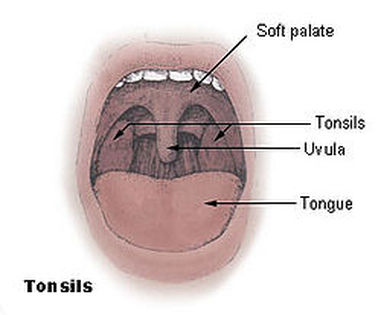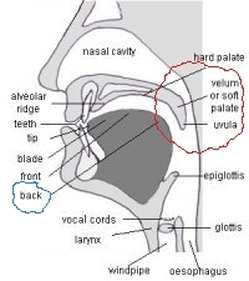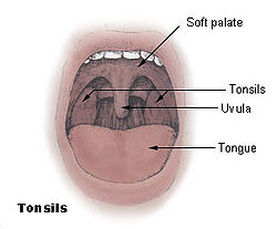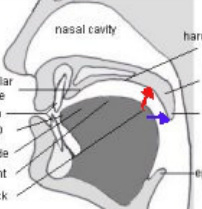Uvular Awareness
The first step to mastering a new motor movement is to develop a physical awareness of it. The two things you want to focus on are location and movement of your mouth.
In this page, you will learn how to make Uvular consonant sounds. Study the visual diagrams then do the exercises. By the end of this section, you should know what a uvular consonant sounds AND feels like.
In this page, you will learn how to make Uvular consonant sounds. Study the visual diagrams then do the exercises. By the end of this section, you should know what a uvular consonant sounds AND feels like.
What is the Uvula?
|
The uvula is the dangly thingy at the back of your mouth (no need to get technical here). You were probably fascinated by it as a child, and wondered if it served any other purpose than to wiggle whenever grown-ups snored.
You articulate the French 'r' sounds at the Uvula. You make these sounds by raising the backmost part of the tongue UP to the uvula to restrict air flow. Even though the sound is called "uvular," your tongue is actually the only active agent. Your real goal is to build an awareness of the backmost part of your tongue and learn how to adjust it so that it comes in contact with the uvula. |
Building awareness of the uvular consonant can be tricky. Again, we don't use this in English so it will be new for you. Below I give you some examples of uvular sounds and walk you through the process of how to make it. It will take you some time, but you'll eventually get it.
Step 1: Find the Velum
Since the uvula isn't apart of Englush language, let's first try to find the next closest thing. This is the velum (also called the soft palete).
You create the uvular sound by raising the back of your tongue to the uvula. In the same way, you create the velar sound by raising the back of your tongue to the velum.
Looking at the two diagrams below, you see that the velum is directly above the uvula. Since the back of the tongue is already so close, it doesn't need to move much to approach the velum or uvula.
You create the uvular sound by raising the back of your tongue to the uvula. In the same way, you create the velar sound by raising the back of your tongue to the velum.
Looking at the two diagrams below, you see that the velum is directly above the uvula. Since the back of the tongue is already so close, it doesn't need to move much to approach the velum or uvula.
In the audio file below I repeat the two velar sounds in English - /k/ and /g/. To create these sounds, you first raise the back of the tongue up to the velum and block air to build up pressure. Then you lower your tongue and release the pressure in a burst of air. The difference between /k/ and /g/ is that for one you are also vibrating your vocal chords.
|
|
Step 2: Change Direction
Before moving on, we must review three key points from the last step:
- Velar consonants are created by raising the back of the tongue to the velum
- Uvular consonants are created by raising the back of the tongue to the uvula
- The uvula is located directly below the velum
Therefore...
The only difference between a velar consonant and an uvular consonant
is the direction in which you move the back of your tongue.
is the direction in which you move the back of your tongue.
|
So, you create the velar consonant with an diagonal-backward motion of the tongue (red arrow). You create the uvular consonant with only a straight-backward motion.
It will probably take you some time to feel out this straight-back motion and find your uvular consonant sweet spot, but at least now you know which general direction you need to go. |
In the audio below, I go back and forth between the velar fricative (doesn't exist in English) and the uvular fricative. You can try to repeat if you wish, but don't worry about mimicking so much. I am only including this audio so that you can can hear the difference between a velar and uvular consonant sound.
Step 3: Feel it Out
Now that you have a basic idea of where the uvular lives, you just have to spend some time fooling around until you can pinpoint it in your own speech.
In the audio files below, I articulate all three of the uvular sounds relevant to French. Listen closely and try your best to mimic. Do not worry about getting the sound for now, as I will describe each sound in more detail in the following pages.
In the audio files below, I articulate all three of the uvular sounds relevant to French. Listen closely and try your best to mimic. Do not worry about getting the sound for now, as I will describe each sound in more detail in the following pages.
While feeling these sounds out, be sure to:
- Keep the front/middle of your tongue (what you can see in a mirror) completely relaxed at the bottom of your mouth.
- Keep the tip of your tongue resting against the back of your lower teeth/gumline.
- Do NOT pull your tongue back.
- Do NOT do any excess movements with your lips or tongue (make the uvular consonant in a single movement).
|
|
|
|
Step 4: Differentiating From Other "Rhotic Sounds"
The rhotic sounds are a special category of speech sounds. In roman-script writing systems, these sounds are represented by the letter "r". Even though they vary a great deal acoustically and physically in their articulation, it is easy to mix them up.
The uvular consonants are all rhotic sounds. Since they do not exist in English, there is a large chance that you will misperceive it as a different rhotic sound.
The most common error of this type is to replace the Uvular consonant with the English 'r', but there are others as well.
In the audio files below, I compare the Uvular Consonant of French with other rhotic sounds. Listen and make sure you can make the distinction before moving on.
The uvular consonants are all rhotic sounds. Since they do not exist in English, there is a large chance that you will misperceive it as a different rhotic sound.
The most common error of this type is to replace the Uvular consonant with the English 'r', but there are others as well.
In the audio files below, I compare the Uvular Consonant of French with other rhotic sounds. Listen and make sure you can make the distinction before moving on.
|
As an English speaker, this will be the rhotic sound you will most frequently lean toward.
|
This is the velar consonant from the previous step. Note that velar consonants and uvular consonants are NOT the same.
|
In many accents of French, this sound will completely replace the uvular consonant in speech.
|
Hopefully now you have a basic feel for the uvular consonant. Don't worry if you were unable to do it on your first try. Like I said before, your motor skills take exposure and practice to develop. Just make sure to refer to this page whenever you are stuck.
As your familiarity with French sounds and the uvular consonants grow, you'll eventually find it become automatic to reproduce these sounds when you speak French!
As your familiarity with French sounds and the uvular consonants grow, you'll eventually find it become automatic to reproduce these sounds when you speak French!
Once you are comfortable with everything on this page, you may move onto The Next Section





